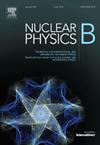Nonlinear electrodynamics effects on the geometry, thermodynamics, and quantum dynamics of (2+1)-dimensional black holes
IF 2.5
3区 物理与天体物理
Q2 PHYSICS, PARTICLES & FIELDS
引用次数: 0
Abstract
Black holes in dimensions serve as valuable toy models for understanding key aspects of real astrophysical black holes, providing insights into quantum gravity and thermodynamic properties. In this work, we present a novel -dimensional black hole solution coupled with nonlinear electrodynamics (NLED). This extension of the well-known charged Bañados-Teitelboim-Zanelli (BTZ) black hole allows for a detailed investigation of the geometric and thermodynamic properties influenced by nonlinear electromagnetic fields. The introduction of the NLED parameter α modifies the black hole metric, leading to significant corrections in thermodynamic quantities such as the Hawking temperature and entropy. Using quantum tunneling methods, we derive the modified Hawking temperature, showing its explicit dependence on NLED corrections. Furthermore, we analyze entropy modifications that incorporate quantum statistical mechanics methods, revealing the impact of logarithmic corrections and the Generalized Uncertainty Principle (GUP). Additionally, we examine the propagation of a massive scalar field in this black hole background by solving the radial Klein-Gordon equation numerically. The NLED parameter introduces additional terms in the effective potential, affecting quantum field scattering, particle trapping, and the behavior of the photon sphere. We further study geodesic motion and highlight the influence of NLED on the deflection of light and the black hole shadow, suggesting potential observational signatures of these corrections. Finally, we investigate fundamental frequencies associated with quasi-periodic oscillations (QPOs) in the black hole accretion disk, offering a possible avenue for testing NLED effects through astrophysical observations. Therefore, this study offers insights into the observable signatures of NLED-modified black holes and their potential relevance in astrophysical and gravitational wave experiments.
非线性电动力学对(2+1)维黑洞几何、热力学和量子动力学的影响
(2+1)维度的黑洞为理解真实天体物理黑洞的关键方面提供了有价值的玩具模型,为量子引力和热力学特性提供了见解。在这项工作中,我们提出了一种新的(2+1)维黑洞解与非线性电动力学(NLED)耦合。这个众所周知的带电Bañados-Teitelboim-Zanelli (BTZ)黑洞的扩展允许对非线性电磁场影响的几何和热力学性质进行详细的研究。NLED参数α的引入改变了黑洞度量,导致了霍金温度和熵等热力学量的重大修正。利用量子隧道的方法,我们得到了修正的霍金温度,显示了它对NLED修正的显式依赖。此外,我们分析了包含量子统计力学方法的熵修正,揭示了对数修正和广义不确定性原理(GUP)的影响。此外,我们通过数值求解径向Klein-Gordon方程来研究大质量标量场在该黑洞背景中的传播。NLED参数在有效势中引入了额外的项,影响量子场散射、粒子捕获和光子球的行为。我们进一步研究了测地线运动,并强调了NLED对光偏转和黑洞阴影的影响,提出了这些修正的潜在观测特征。最后,我们研究了黑洞吸积盘中与准周期振荡(QPOs)相关的基频,为通过天体物理观测测试NLED效应提供了可能的途径。因此,这项研究为nled修饰黑洞的可观测特征及其在天体物理和引力波实验中的潜在相关性提供了见解。
本文章由计算机程序翻译,如有差异,请以英文原文为准。
求助全文
约1分钟内获得全文
求助全文
来源期刊

Nuclear Physics B
物理-物理:粒子与场物理
CiteScore
5.50
自引率
7.10%
发文量
302
审稿时长
1 months
期刊介绍:
Nuclear Physics B focuses on the domain of high energy physics, quantum field theory, statistical systems, and mathematical physics, and includes four main sections: high energy physics - phenomenology, high energy physics - theory, high energy physics - experiment, and quantum field theory, statistical systems, and mathematical physics. The emphasis is on original research papers (Frontiers Articles or Full Length Articles), but Review Articles are also welcome.
 求助内容:
求助内容: 应助结果提醒方式:
应助结果提醒方式:


